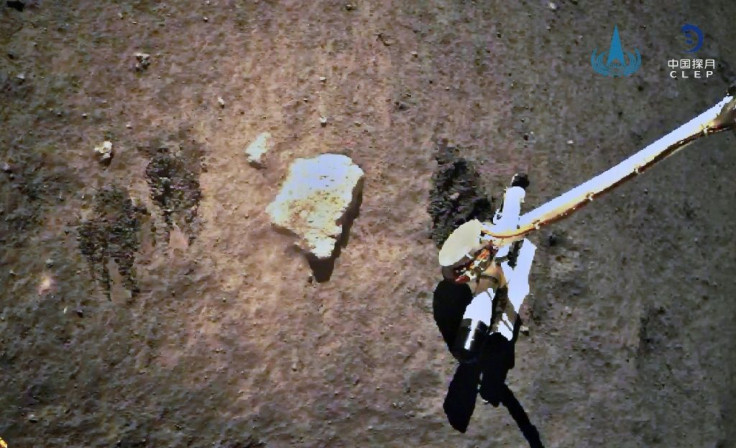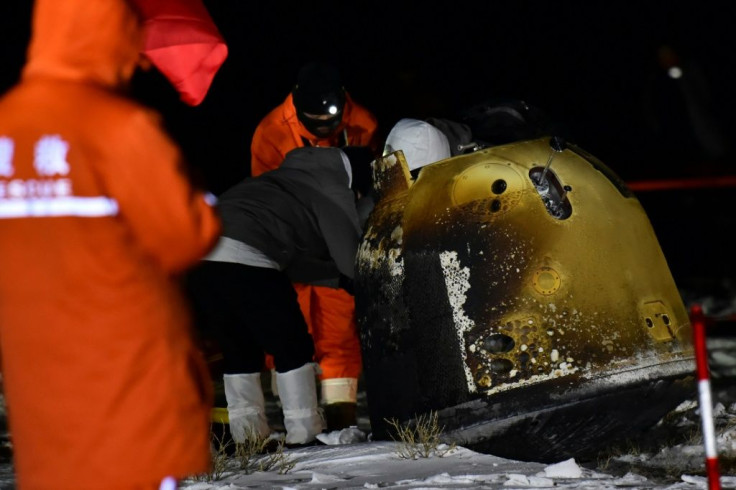Chinese Craft Returns To Earth With Moon Rocks
An unmanned Chinese spacecraft carrying rocks and soil from the Moon returned safely to Earth early Thursday, completing another chapter in China's effort to become a space superpower.
The mission was the first in four decades to collect lunar samples, emulating the feats of the United States and the Soviet Union from the 1960s and 1970s -- and going a few steps further.
Scientists hope the samples will give insights into the Moon's origins and volcanic activity, though a more immediate focus was on how the mission showcased China's technological advances.
"China has been preparing for this for a long time," Jonathan McDowell, a Harvard-Smithsonian Center for Astrophysics researcher, told AFP.

"This was very important to them -- and still risky, as the automatic rendezvous, docking and sample transfer in lunar orbit had never been done before, by anyone. It's a sign of the maturity of the Chinese space effort that it went off so flawlessly."
In images broadcast on state television, the blackened capsule landed on snow-covered grasslands in darkness in the country's remote north.
A Chinese flag was quickly placed next to the capsule, reflecting the nationalist pride that the multi-billion-dollar space programme engenders.

China launched its first satellite in 1970 but human spaceflight took decades longer -- with Yang Liwei becoming the country's first "taikonaut" in 2003.
Under President Xi Jinping, who took power in 2012, China's "space dream" has been put into overdrive.
A Chinese lunar rover landed on the far side of the Moon in January 2019, a global first.

The official Xinhua news agency described the latest mission as one of the most challenging and complicated in China's aerospace history.
Chang'e-5 -- named after a mythical Chinese Moon goddess -- landed on the Moon on December 1.
During two days on the Moon, it collected two kilogrammes (4.5 pounds) of material in an volcanic area called Mons Ruemker in the Oceanus Procellarum -- or "Ocean of Storms" -- which was previously unexplored, China's space agency said.
While there it also raised the Chinese flag, according to the agency.

The probe's departure was also the first time China had achieved take-off from an extraterrestrial body.
The module then went through the delicate operation of linking up in lunar orbit with the part of the spacecraft that brought the samples back to Earth.
The probe comprised separate craft to get to the Moon, land on it and collect the samples, get back up and then return the rocks and soil to Earth.
The return capsule entered the Earth's atmosphere at an altitude of about 120 kilometres (75 miles).
When it was about 10 kilometres above land, a parachute opened and it landed smoothly, the space agency said.
"With this successful mission, China will be more confident of its own technologies," Chen Lan, an independent analyst at GoTaikonauts.com, which specialises in China's space programme, told AFP.
Thomas Zurbuchen, a top official at NASA's science mission directorate, also congratulated China on the safe return of the capsule.
"The international science community celebrates your successful Chang'e 5 mission," he tweeted.
"These samples will help reveal secrets of our Earth-Moon system (and) gain new insights about the history of our solar system."
The capsule will be airlifted to Beijing for opening, and the Moon samples will be delivered to a research team for analysis and study.
China had already said it would be willing to share the samples from the moon, and the space agency's director said after the capsule landed that Beijing would "cooperate extensively" with global scientists.
Chinese officials said some of the moon material would be displayed in the country's National Museum and others would be sent to Mao Zedong's hometown in central China, as a tribute to the late Chinese Communist Party leader.
China's future space goals include creating a powerful rocket capable of delivering payloads heavier than those NASA and private rocket firm SpaceX can handle.
It is aiming for a crewed space station by 2022 and eventually to send humans to the Moon.
© Copyright AFP 2024. All rights reserved.





















